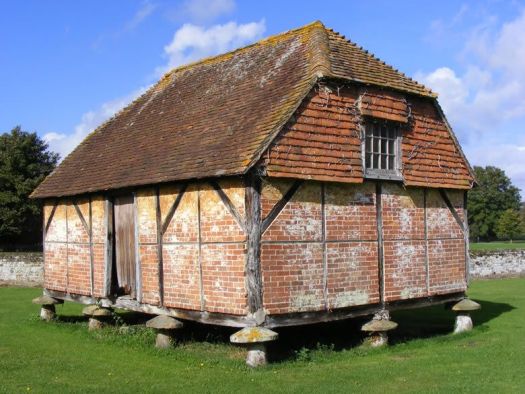Granary
Granaries are stone buildings designed to store and preserve threshed grain or animal feed. Grain must be kept from moisture for as long as possible to preserve it in good condition and prevent mold. Granaries are erected away from inhabited buildings, as any chimney or hearth represents a source of danger to the dry grain they contain.
Contents
To provide sufficient storage capacity for seven years of grain, for 2 bread symbols, requires a volume of 5,735 cub.ft. This makes a building that's 13 ft. high, 20 ft. wide and 22 ft. long. In most parts, multiple granaries are built, so that a building might be emptied and the grain moved elsewhere in case of damp. Spoilage of grain is notably heavier in years of abundance, whereas during times of famine the lesser amount of grain that's left can be more closely managed.
Despite the tremendous importance a granary has for a community, each is managed privately in Europe by a freemason. India assigns the management of grain as a matter of caste, while China's bureaucracy serves the equivalent storage of rice production. Each set of three granaries are managed by a single family of 3-8 persons, with three full-time labourers, adding 6-11 persons to the population (d6+5).
Preparing Grain
Newly harvested grain brought into a granary tends to contain excess moisture, so it's traditionally spread in thin layers on a dry barn floor, to aerate it thoroughly. This can take between 5 days and six weeks, depending on the climate; if not dry by six weeks, 10% of the yield must be culled from the remainder and the grain taken to a drier, underground space. If one isn't available, the whole crop may be lost. Once the grain is sufficiently dry, it can be transferred to the granary.
Storage
Once in the granary, grains are stored in massive earthenware jars specially designed to maintain a cool, dark environment. Baskets and sacks do serve, but it's best to transfer grain in these to jars after the first year. If managed well, grain can be stored for seven years, which is vital given the dangers of one or more years of drought and lost crops during that time. A community's welfare depends upon the careful management of its existing grain, which is expected to last much more than a single year.
To preserve grain, it has to be moved, or "poured," over and over again, to keep it dry. Thus the granary keeper is kept working by this necessity.
Construction
Granaries have different designs based on storage volume. While smaller stores are built in hamlets, larger stores are located in castles and monasteries (tithe barns), at ports or within cities. One small granary of the size described above (13 x 20 x 22 ft.) is built upon
